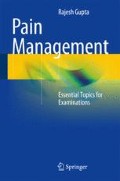Abstract
It is a demyelinating disease involving the central nervous system. Onset is usually seen mostly after the second decade of life. Prevalence in Europe is 4–8/100 of population. Various pain syndromes are seen in multiple sclerosis. Most commonly seen are paraesthesias. The pain felt may be continuous or paroxysmal. Paroxysmal pain responds better to anticonvulsants. Continuous pain is typically of burning or aching type and seen more in lower extremities than in upper extremities. It responds better to antidepressants and NMDA receptor antagonists. Trigeminal neuralgia is commonly seen. It is seen at a younger age and is mostly bilateral. It responds well to medical management but is refractory to surgical intervention. Patients may present with spasticity due to the involvement of corticospinal or corticobulbar tracts. A classical sign is Lhermitte’s phenomenon seen due to involvement of the dorsal horn. Painful muscle spasms are seen on flexion of the neck, spreading down to the back and legs. Headaches may be seen during the course of illness. The most common location of pain are the legs, hands and feet. Optic neuritis may be seen. One third of patients become disabled due to involvement of the musculoskeletal system.
Keywords
These keywords were added by machine and not by the authors. This process is experimental and the keywords may be updated as the learning algorithm improves.
34.1 Multiple Sclerosis
It is a demyelinating disease involving the central nervous system. Onset is usually seen mostly after the second decade of life. Prevalence in Europe is 4–8/100 of population. Various pain syndromes are seen in multiple sclerosis. Most commonly seen are paraesthesias. The pain felt may be continuous or paroxysmal. Paroxysmal pain responds better to anticonvulsants. Continuous pain is typically of burning or aching type and seen more in lower extremities than in upper extremities. It responds better to antidepressants and NMDA receptor antagonists. Trigeminal neuralgia is commonly seen. It is seen at a younger age and is mostly bilateral. It responds well to medical management but is refractory to surgical intervention. Patients may present with spasticity due to the involvement of corticospinal or corticobulbar tracts. A classical sign is Lhermitte’s phenomenon seen due to involvement of the dorsal horn. Painful muscle spasms are seen on flexion of the neck, spreading down to the back and legs. Headaches may be seen during the course of illness. The most common location of pain are the legs, hands and feet. Optic neuritis may be seen. One third of patients become disabled due to involvement of the musculoskeletal system.
34.2 Central Post-stroke Pain
It is the most common cause of central neuropathic pain. It can occur with both ischaemic and haemorrhagic types of stroke. Most cases are ischaemic because of predominance of ischaemic strokes. Infarction of the lateral medulla (Wallenberg’s syndrome) has the highest incidence of central post-stroke pain. The incidence is also high with thalamic infarcts involving the ventral posterior nuclei or posterior insula. The pain mostly occurs within 3 months of the stroke. The pain is severe and is constant with mild fluctuations in intensity. The most common type of pain is the burning type and involves the entire side of the body. The most intense pain is seen in thalamic patients. Abnormal thermal sensations accompany the pain due to involvement of the spinothalamic tract. Allodynia and dysaesthesias are seen. Amitriptyline (75 mg/day) and lamotrigine (200 mg/day) has shown equal efficacy for the management of pain and are drugs of first choice. Intravenous infusions of lignocaine and ketamine can be used for short-term control of pain. Motor cortex stimulation is effective in 50 % of the patients and provides short-term pain relief for up to 5 h.
34.3 Spinal Cord Injury Pain
The pain in spinal cord injury is seen in two thirds of the patients. It can be secondary to various causes like ischaemia, inflammation, infection or trauma itself. The pain is a result of various tracts, predominant of which is the spinothalamic tract. Others involved are the spinoreticular tract, spinomesencephalic tract, spinobrachial system and spinopontoamygdaloid pathway (associated with wind-up). Thalamus may be involved due to central sensitisation. Most commonly, musculoskeletal pain is seen due to injury itself or due to complications of the injury (muscular atrophy, dislocations). Visceral pain due to constipation, stone formation in the kidneys or infection is seen. Neuropathic pain may present at the level of the injury or below the level of the injury. At the level of the injury, neuropathic pain presents as a girdle-like pain along the dermatome of the level involved. Management includes analgesics, physical treatment (massage, heat) and psychological treatment. Clonidine (α2 agonist) has been found effective against neuropathic pain when given via the epidural route. Acupuncture has also shown efficacy in neuropathic pain. Baclofen (GABA receptor agonist) is effective for muscle spasms. Stimulation techniques like spinal cord stimulation and deep brain stimulation have shown efficacy if there is partial preservation of sensation.
Author information
Authors and Affiliations
Rights and permissions
Copyright information
© 2014 Springer-Verlag Berlin Heidelberg
About this chapter
Cite this chapter
Gupta, R. (2014). Central Pain Syndromes. In: Pain Management. Springer, Berlin, Heidelberg. https://doi.org/10.1007/978-3-642-55061-4_34
Download citation
DOI: https://doi.org/10.1007/978-3-642-55061-4_34
Published:
Publisher Name: Springer, Berlin, Heidelberg
Print ISBN: 978-3-642-55060-7
Online ISBN: 978-3-642-55061-4
eBook Packages: MedicineMedicine (R0)

